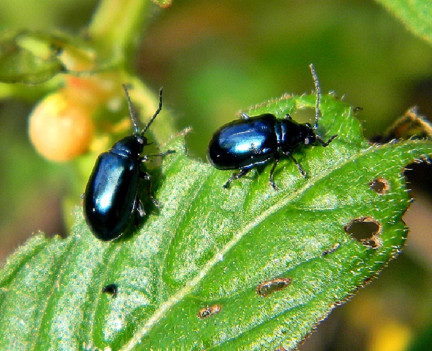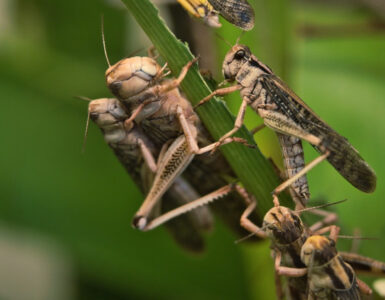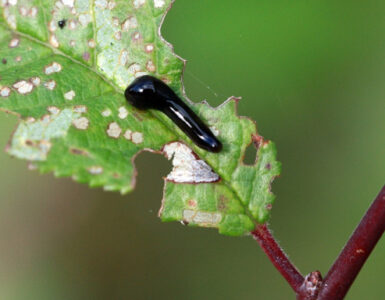Flea beetles are small jumping beetles that feed on many crops in the garden. They mainly feed on brassicas and related plants.
So, a flea beetle infestation can cause significant damage to your vegetable garden. Therefore, please make every effort to get rid of these beetles as soon as you see the first sign of them.
Identification
Flea beetles are of the leaf beetle family (Chrysomelidae). They go through four life stages: egg, larva, pupa, and adult [1].
Flea beetles can cause crop damage in both larval and adult stages. The adult beetles feed on leaves, while the larvae go after roots.
Flea beetles will feed on cabbage, arugula, spinach, bok choy, broccoli, and kale. They will also go after turnips, radishes, horseradish, and other root vegetables.
Flowering plants with tubers, such as potatoes, and other crops, such as tomatillos, peppers, tomatoes, eggplant, lettuce, and Cape gooseberries, are also host plants for these pests.
How to Get Rid of Flea Beetles Naturally
Below are some home remedies and organic solutions that work against flea beetles.
1. Neem Oil
Neem oil, a botanical insecticide, is one of the best organic remedies for controlling flea beetles. It deters and even kills many insects.
It is excellent for repelling beetles, bugs, and other insect pests. The treatment also helps to prevent some plant diseases.
Therefore, you can use it to make an organic flea beetle spray. Combine four teaspoons of neem oil with one teaspoon of organic liquid soap and 1 gallon of warm water.
Shake well and spray on the plants.
2. Insecticidal Soap
You can make insecticidal soap from water, vegetable oil, and pure organic liquid soap. This potent, soapy water solution will kill flea beetles.
Combine five tablespoons of liquid soap, one cup of vegetable oil, and one gallon of water for the recipe. Shake well, then spray it directly onto the beetles.
This homemade insecticidal spray will also address many other insect pest problems.
3. Repellent Plants
Several plants repel flea beetles. These include sage, nasturtiums, catnip, mint, basil, and French marigolds.
Plant them next to crops like eggplant, peppers, collards, kale, and tomatoes. This helps to keep flea beetles away.
4. Till Soil
Till the soil before the fall to expose any beetles that may have been hiding there. This action will expose them to predators that will eat them.
5. Trap Crops
You can plant these plants between your crops or on the edges of your vegetable garden to serve as sacrificial plants.
Flea beetles will flock to daikon, radishes, and Pacific Gold mustard. Therefore, planting these as trap crops will attract the beetles, drawing them away from your vegetables.
6. Sticky Traps
These traps are mainly utilized to help control an infestation rather than to prevent one. Sticky traps are available online and at most farm stores.
But you can also make a flea beetle sticky trap using strips of white or yellow plastic coated with a sticky substance, like non-drying glue.
7. Beauveria bassiana
Beauveria bassiana is another organic remedy for flea beetle control [2].
It doesn’t need to be consumed by the beetles, either. Just being touched by the spores will sicken the beetles so severely that they will eventually die.
If you get it from a store and want to apply it in your garden, follow the instructions carefully.
8. Coffee Grounds
Using coffee grounds to control flea beetles in the garden is a popular home remedy among gardeners. It will repel these pests, as they hate the smell.
However, be careful with which plants you put coffee grounds around. While coffee grounds are an excellent natural fertilizer for some plants, they can harm others.
9. Diatomaceous Earth
Used as an organic gardening pesticide, this product is fatal to many insect pests. It cuts up soft-bodied insects, such as flea beetle larvae, killing them.
To use diatomaceous earth for flea beetles, spread it around the base of the plants. However, reapply after heavy watering or after there has been rainfall.
You can also use food-grade diatomaceous earth to get rid of flea beetles in the house.
10. Row Covers
Install row covers over the seedlings as they grow.
However, remove them when the plants start to flower, or your pollinators will have less to feed on.
11. Natural Predators
Ground beetles, some birds, and toads are natural predators of flea beetles. Braconid wasps will also kill these pests.
With some research, you can find out which natural predators are native to your area and how to attract them.
12. Beneficial Nematodes
Beneficial nematodes will also go after the larval stage of these pests. They enter their bodies and feed on them.
13. Control Weeds
Pulling weeds from your garden will help prevent beetles from roaming about and moving from the weeds to your plants.
14. Kaolin Clay
Kaolin clay can be mixed with water to form a spray. When it dries, it creates a barrier between flea beetles and your plants.
15. Mulch
A thick layer of mulch around plants will make it difficult for flea beetle larvae to emerge and later become adults.
Takeaway
Flea beetles are among the worst pests a gardener can face. Don’t wait until there is an infestation to try the above natural remedies.








Add comment